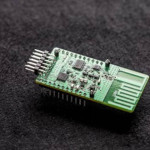
WHY THIS MATTERS IN BRIEF
IoT devices only “work” if they have connectivity, but up until now trying to get data from a sensor in a field, or a toaster at home, has meant fitting them all with battery powered communications gear, new backscatter devices solve that issue.
A little while ago Eric Schmidt, one of Google’s founders, announced that the “internet is disappearing,” and ironically it turns out he’s not as far off the mark as many people might at first think. After all, the internet as it once was, where we all simply accessed content and information via a browser, is now increasingly being augmented and replaced by the world of connected things that surrounds us. In short, the internet as we knew it is quickly becoming just a subset of the new Internet of Things (IoT) revolution that includes things like connected cars, wearables and anything and everything that “connects” to something else, so yes, the “internet” as we knew it is arguably “dead.”
There’s little doubt in anyone’s mind that the IoT will revolutionise our world, and that the new capabilities it affords us are already helping us transform everything from agriculture, energy and healthcare to manufacturing, retail and transportation. Crops tell us when they’re thirsty and parking spaces tell us when they’re vacant, power poles tell us when they’ve collapsed, implanted medical devices notify us about impending heart attacks and jet engines tell us when they need replacement parts, and much else besides.
Small buy Mighty
Despite all this, however, connecting most devices is still an expensive and cumbersome process. Sure there have been some breakthroughs, we’ve seen computers the size of grains of rice, and even diamond batteries that last forever, but despite all these and more there’s still a big gap in our armoury – trying to get today’s chips and sensors to communicate over long distances when, for example, they’re in the middle of a field, is still basically impossible unless you’re willing to use a load of expensive radio communications gear and big batteries. But now thanks to the same team at the University of Washington (UW), who recently unveiled the world’s first battery free smartphone, and made calls from it, and the world’s first “No Power WiFi” device, that might be one problem we might soon be able to tick off our list.
“Today’s radio technology [devices] cost at least $4, making them too expensive for embedding into objects at scale,” says Dr. Joshua Smith, a professor of computer science at UW, and a leading expert on wireless systems passive energy harvesting.
The high cost comes not just from the radio transmitters needed for systems like Wi-Fi and Bluetooth but, at the moment at least, from the batteries they need for power. So Smith and his team set out to build a low-cost communications system that doesn’t need batteries or the energy they provide.
Communicating without using any energy might sound impossible but actually it isn’t as hard as you might think, it just takes a little lateral thinking. Consider, for example, a shipwrecked sailor who signals rescuers by reflecting sunlight from a mirror.
Now Smith and his team have developed miniature computer chips that can communicate over long distances using the same technology we first saw in the No Power WiFi breakthrough I mentioned earlier, something called “Backscatter.” Backscatter technologies use tiny antennas to absorb or reflect ambient radio waves in the air from a transmitter, such as a traditional household WiFi router, and then create a faint but distinctive echo of the original signal that can be detected and decoded by a receiver over significant distances. And because they have no power-hungry transmitter, Smith says, backscatter devices can get all the energy they need from thin air — or, rather, from the radio and TV broadcasts that fill it.
At home, that could mean a single WiFi router talking to dozens of tiny devices mounted on fridges, doorbells, and the like, none of which would have to have their own energy source. How about a smart coffee mug that tells you when your favourite beverage is getting cold? And out in the world, the IoT could save crops or bust traffic jams with ease.
“What you’d like to have is thousands of devices that are extremely low power, potentially battery free, and able to communicate at long range,” Smith says.
In a recent paper, his team demonstrated a backscatter chip that could send information to a receiver as far away as two miles, and that’s far enough to work across all but the biggest farms, not to mention throughout a family home or even a large office.
Smith says the backscatter chips could be manufactured for less than a twenty five cents or less, and he thinks that should be inexpensive enough to unlock dozens of IoT applications, including Connected Homes that heat or light rooms only when humans were present and bridges that signal when they’re about to fail.
But Smith is convinced that the most exciting uses for the technology will be medical. In a recent experiment, his team built backscatter into a soft contact lens and placed it in contact lens fluid to simulate being in an eye. A receiver was able to pick up data from the lens from across the room.
Smith’s team also made a prototype skin sensor to be worn as a sticker. Such a wireless sensor would enable simple, continuous monitoring of vital signs like temperature, sweat, and cardiac activity. Or imagine an implant that could warn medical staff it was malfunctioning. Smith is now concentrating on perfecting the development of IoT chips that generate only trickles of data.
“But when you add together thousands of sensors, the net amount of data coming into one reader may be quite high,” he says, and he isn’t the only one who sees the promise of backscatter.
“This is a very promising technology, which when combined with other techniques for precision positioning, it could really open up the internet of things to a wide world,” says David Mindell, CEO of Humatics, a Cambridge, Massachusetts based firm that is building an indoor GPS-like location system.
In the meantime Smith has formed his own startup Jeeva Wireless to commercialise his backscatter technologies, and even if his battery free systems prove tricky to build there is undoubtedly going to be plenty of interest.


















We have too much data to assimilate and handle already and if we hand it over to the machines then what’s the point of living?
[…] the kind of high-powered processors normally used for AI. They also tend to run on batteries or energy harvested from the environment, and so can’t meet the demanding power requirements of conventional deep learning […]